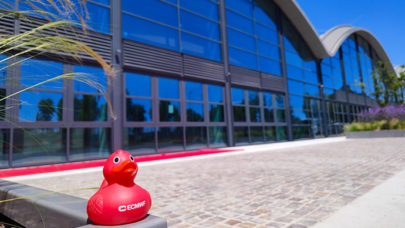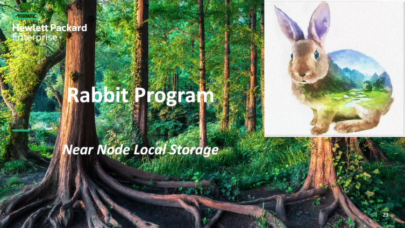
NCSA’s Delta System Enters Full Production
October 5, 2022
In June 2020, the NSF awarded the National Center for Supercomputing Applications (NCSA) $10 million for its post-Blue Waters “Delta” supercomputer. Now, th Read more…

Citing ‘Shortfalls,’ NOAA Targets Hundred-Fold HPC Increase Over Next Decade
January 5, 2022
From upgrading the Global Forecast System (GFS) to acquiring new supercomputers, the National Oceanic and Atmospheric Administration (NOAA) has been making big moves in the HPC sphere over the last few years—but now it’s setting the bar even higher. In a new report, NOAA’s Science Advisory Board (SAB) highlighted... Read more…

US Closes in on Exascale: Frontier Installation Is Underway
September 29, 2021
At the Advanced Scientific Computing Advisory Committee (ASCAC) meeting, held by Zoom this week (Sept. 29-30), it was revealed that the Frontier supercomputer is currently being installed at Oak Ridge National Laboratory in Oak Ridge, Tenn. The staff at the Oak Ridge Leadership... Read more…

ECMWF Opens Bologna Datacenter in Preparation for Atos Supercomputer
September 14, 2021
In January 2020, the European Centre for Medium-Range Weather Forecasts (ECMWF) – a juggernaut in the weather forecasting scene – signed a four-year, $89-million contract with European tech firm Atos to quintuple its supercomputing capacity. With the deal approaching the two-year mark, ECMWF... Read more…

Microsoft to Provide World’s Most Powerful Weather & Climate Supercomputer for UK’s Met Office
April 22, 2021
More than 14 months ago, the UK government announced plans to invest £1.2 billion ($1.56 billion) into weather and climate supercomputing, including procuremen Read more…

HPE Names Justin Hotard New HPC Chief as Pete Ungaro Departs
March 2, 2021
HPE CEO Antonio Neri announced today (March 2, 2021) the appointment of Justin Hotard as general manager of HPC, mission critical solutions and labs, effective Read more…

Livermore’s El Capitan Supercomputer to Debut HPE ‘Rabbit’ Near Node Local Storage
February 18, 2021
A near node local storage innovation called Rabbit factored heavily into Lawrence Livermore National Laboratory’s decision to select Cray’s proposal for its CORAL-2 machine, the lab’s first exascale-class supercomputer, El Capitan. Details of this new storage technology were revealed... Read more…

Air Force Launches Cray Weather Forecasting Supercomputer in Partnership with HPE, ORNL
February 10, 2021
The U.S. Department of Energy's Oak Ridge National Laboratory (ORNL) is now home to one of the first HPE Cray EX supercomputing deployments, which ORNL's Nation Read more…

- Click Here for More Headlines

Whitepaper
Transforming Industrial and Automotive Manufacturing
In this era, expansion in digital infrastructure capacity is inevitable. Parallel to this, climate change consciousness is also rising, making sustainability a mandatory part of the organization’s functioning. As computing workloads such as AI and HPC continue to surge, so does the energy consumption, posing environmental woes. IT departments within organizations have a crucial role in combating this challenge. They can significantly drive sustainable practices by influencing newer technologies and process adoption that aid in mitigating the effects of climate change.
While buying more sustainable IT solutions is an option, partnering with IT solutions providers, such and Lenovo and Intel, who are committed to sustainability and aiding customers in executing sustainability strategies is likely to be more impactful.
Learn how Lenovo and Intel, through their partnership, are strongly positioned to address this need with their innovations driving energy efficiency and environmental stewardship.
Download Now
Sponsored by Lenovo
Whitepaper
How Direct Liquid Cooling Improves Data Center Energy Efficiency
Data centers are experiencing increasing power consumption, space constraints and cooling demands due to the unprecedented computing power required by today’s chips and servers. HVAC cooling systems consume approximately 40% of a data center’s electricity. These systems traditionally use air conditioning, air handling and fans to cool the data center facility and IT equipment, ultimately resulting in high energy consumption and high carbon emissions. Data centers are moving to direct liquid cooled (DLC) systems to improve cooling efficiency thus lowering their PUE, operating expenses (OPEX) and carbon footprint.
This paper describes how CoolIT Systems (CoolIT) meets the need for improved energy efficiency in data centers and includes case studies that show how CoolIT’s DLC solutions improve energy efficiency, increase rack density, lower OPEX, and enable sustainability programs. CoolIT is the global market and innovation leader in scalable DLC solutions for the world’s most demanding computing environments. CoolIT’s end-to-end solutions meet the rising demand in cooling and the rising demand for energy efficiency.
Download Now
Sponsored by CoolIT
Advanced Scale Career Development & Workforce Enhancement Center
Featured Advanced Scale Jobs:
HPCwire Resource Library
HPCwire Product Showcase
© 2024 HPCwire. All Rights Reserved. A Tabor Communications Publication
HPCwire is a registered trademark of Tabor Communications, Inc. Use of this site is governed by our Terms of Use and Privacy Policy.
Reproduction in whole or in part in any form or medium without express written permission of Tabor Communications, Inc. is prohibited.
























